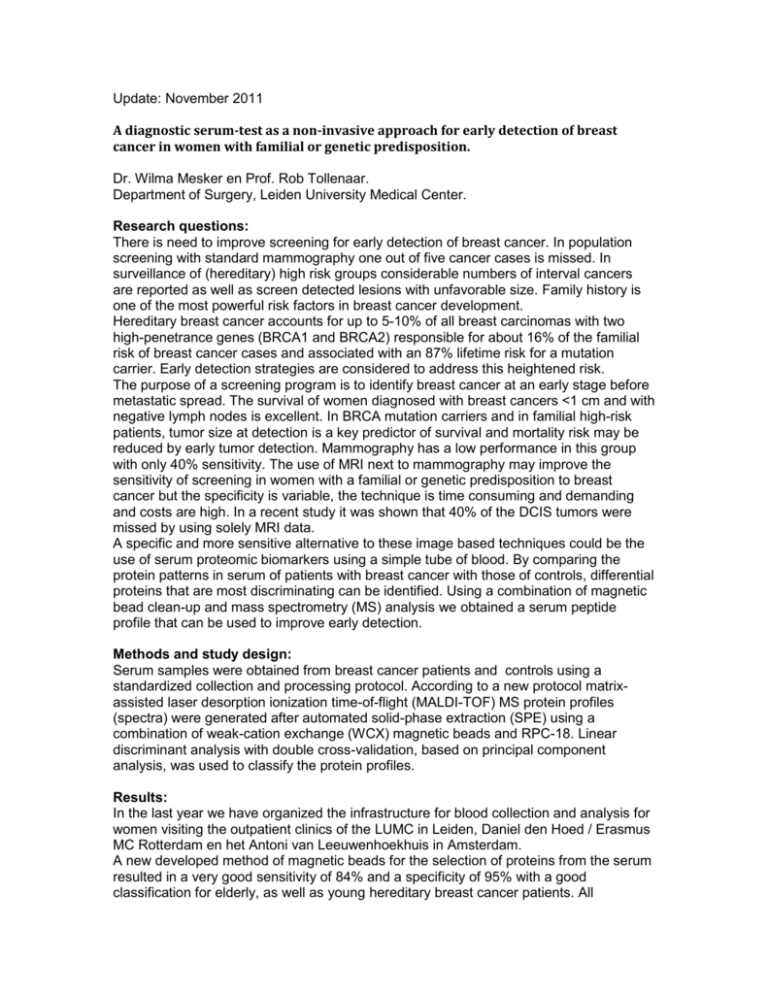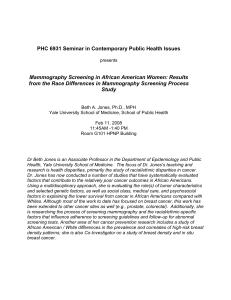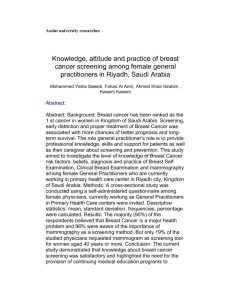A diagnostic serum-test as a non-invasive approach for early
advertisement

Update: November 2011 A diagnostic serum-test as a non-invasive approach for early detection of breast cancer in women with familial or genetic predisposition. Dr. Wilma Mesker en Prof. Rob Tollenaar. Department of Surgery, Leiden University Medical Center. Research questions: There is need to improve screening for early detection of breast cancer. In population screening with standard mammography one out of five cancer cases is missed. In surveillance of (hereditary) high risk groups considerable numbers of interval cancers are reported as well as screen detected lesions with unfavorable size. Family history is one of the most powerful risk factors in breast cancer development. Hereditary breast cancer accounts for up to 5-10% of all breast carcinomas with two high-penetrance genes (BRCA1 and BRCA2) responsible for about 16% of the familial risk of breast cancer cases and associated with an 87% lifetime risk for a mutation carrier. Early detection strategies are considered to address this heightened risk. The purpose of a screening program is to identify breast cancer at an early stage before metastatic spread. The survival of women diagnosed with breast cancers <1 cm and with negative lymph nodes is excellent. In BRCA mutation carriers and in familial high-risk patients, tumor size at detection is a key predictor of survival and mortality risk may be reduced by early tumor detection. Mammography has a low performance in this group with only 40% sensitivity. The use of MRI next to mammography may improve the sensitivity of screening in women with a familial or genetic predisposition to breast cancer but the specificity is variable, the technique is time consuming and demanding and costs are high. In a recent study it was shown that 40% of the DCIS tumors were missed by using solely MRI data. A specific and more sensitive alternative to these image based techniques could be the use of serum proteomic biomarkers using a simple tube of blood. By comparing the protein patterns in serum of patients with breast cancer with those of controls, differential proteins that are most discriminating can be identified. Using a combination of magnetic bead clean-up and mass spectrometry (MS) analysis we obtained a serum peptide profile that can be used to improve early detection. Methods and study design: Serum samples were obtained from breast cancer patients and controls using a standardized collection and processing protocol. According to a new protocol matrixassisted laser desorption ionization time-of-flight (MALDI-TOF) MS protein profiles (spectra) were generated after automated solid-phase extraction (SPE) using a combination of weak-cation exchange (WCX) magnetic beads and RPC-18. Linear discriminant analysis with double cross-validation, based on principal component analysis, was used to classify the protein profiles. Results: In the last year we have organized the infrastructure for blood collection and analysis for women visiting the outpatient clinics of the LUMC in Leiden, Daniel den Hoed / Erasmus MC Rotterdam en het Antoni van Leeuwenhoekhuis in Amsterdam. A new developed method of magnetic beads for the selection of proteins from the serum resulted in a very good sensitivity of 84% and a specificity of 95% with a good classification for elderly, as well as young hereditary breast cancer patients. All patients with a BRCA mutation were correctly classified as malignant. Patients known with DCIS and patients with stage I disease; respectively 95% and 95% were correctly classified. When the classifier was applied to the group of the benign cases, 92% of the patients were correctly classified. Conclusion: With our new protein selection method are all patients with a genetic predisposition correctly classified indicating a potential use for patients who will benefit most from an improved screening method. Furthermore a high percentage of patients with low stages of disease (95%) was recognized. These relatively high discriminating results indicate the potential applicability of serum protein profiles for early detection of breast cancer. The profiles are obtained from a standardized and automated protocol and can be discriminated independently of the chosen statistics. It is suitable for high-throughput analysis, essential for use in a clinical setting. Relevance to Pink Ribbon goals: innovative scientific research: The present proposal builds on the promising data hitherto generated. We propose to evaluate this test in the other academic centers within The Netherlands as an additional screening test next to the current surveillance scheme for individuals at high risk. Blood samples will be collected from patients visiting the outpatient clinics of initially all UMC's for their regular surveillance. Protein profiles will be generated and recommendations will be developed for intensified screening next to the current imaging methods.







